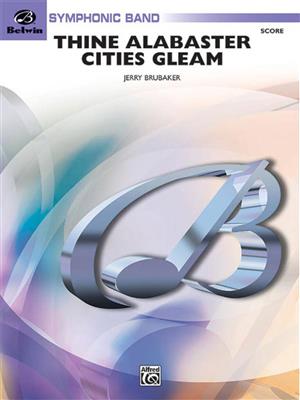Results
-
 £72.99
£72.99Legacy of Honor - Jay Bocook
This impressive work from Jay Bocook opens with a reverent and lush chorale segment interspersed with brief solos for oboe, flute, trumpet, and bassoon. The pace quickens with a grand heroic theme which evolves and intensifiesinto a majestic climax. The mood calms as this beautifully orchestrated and rewarding piece closes in a quiet and delicate manner. Dur: 5:45
Estimated dispatch 7-14 working days
-
 £73.50
£73.50Three Miniatures for Winds and Percussion - Robert Sheldon
Dance like no one is watching, sing like no one is listening and live each day as if it were your last. This famous poem has many versions and is attributed to several authors, yet its simple, eloquent message speaks volumes to millions of people worldwide. The composition therefore has a first movement entitled "Joyful Dance," the second movement is "Simple Song," and the final movement is a "Celebration." Each movement is quite brief but distinctly different, each expressing the feelings inherent in the poem from which the work was drawn. (5:15) This title is available in SmartMusic.
Estimated dispatch 7-14 working days
-
 £33.50
£33.50Spirit of Victory - Sandy Feldstein
The march for your first concert. Using only six notes and no eighth notes, this beginning march will make your group proud of their first performance. A moving bass line to challenge beginners, combined with a catchy melody and traditional march form, make for a perfect beginning band march. (Grade 1---Correlates with Unit 5 of Alfred's Basic Band Method.)
Estimated dispatch 7-14 working days
-
 £82.95
£82.95And in the End It Was Earth - Roland Barrett
Inspired by the Native American proverb, "We do not inherit the earth from our ancestors, we borrow it from our children." Roland Barrett has scored this original composition to musically reflect that sentiment conveying the inherent beauty, majesty, and grandeur of planet Earth. Combining fluid moving melodic components with energetic and driving rhythmic pulse, the work will capture the imagination of all. (5:30) This title is available in SmartMusic.
Estimated dispatch 7-14 working days
-
 £82.95
£82.95And Hope Led Them Home - Justin Williams
This piece celebrates those who inspire us, motivate us, and blaze trails before us, enabling us to be all we can dream to be. With distinct passion and fervor, this new work is sure to be an uplifting and inspiring work for your concert band. (5:45)
Estimated dispatch 7-14 working days
-
£37.95
Hymnsong Variations - Elliot Del Borgo
THE VESPER HYMN is the work upon which this set of variations is based, and the fascinating twisting and turning of the melodic and harmonic material mixes wonderfully with very contemporary rhythmic involvement. Mr. Del Borgo fuses sounds from other generations with those of today. With drive and excitement, this composition flows so comfortably through its tantalizing variants. Powerful! (5:28)
Estimated dispatch 7-14 working days
-
 £80.95
£80.95Overture de Argentina - James D. Ployhar
One of the most fascinating attractions of performance music in almost any medium is the discover and interpretation of sounds that closely identify with cultures as they have developed in nations or regions of our world. With a strong rhythmic drive and intensity, complete with expanded percussion, this work is an overture that celebrates the musical heritage of Latin America. It is a guaranteed audience pleaser with huge potential for effective concert or contest exposure. (5:15)
Estimated dispatch 7-14 working days
-
 £80.95
£80.95Thine Alabaster Cities Gleam - Jerry Brubaker
This stirring original composition was written by the former chief arranger for the United States Navy Band immediately after our national tragedy in September of 2001. Subtitled A Message of Hope for America, it is an emotional work suitable for any program. (5:15)
Estimated dispatch 7-14 working days
-
 £20.50
£20.50Classical Legend - Schaeffer
Tschaikowsky's well known classic from ``Songs for Young People'' opus 54, No. 5 is carefully arranged to suit the abilities of beginning players. Both clarinet parts are below the break, and the simplistic scoring and harmonization are true to the spirit of the original work.
Estimated dispatch 7-14 working days
-
£54.99
The First Christmas Album - Balent
A wonderful ballad type setting for the holiday season. A fresh approach for your next seasonal concert that everyone is sure to love.1. Jingle Bells2. Bring A Torch3. Silent Night4. We Three Kings5. Away In A Manger6. Good king Wenceslas
Estimated dispatch 7-14 working days
